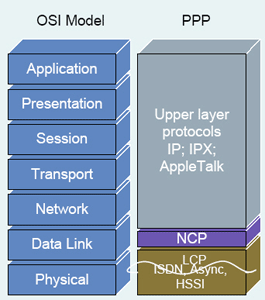Thursday, April 28, 2011
PPP and SLIP Protocols Overview
Do you like this story?
Serial Line Internet Protocol (SLIP):This is a packet-framing protocol and defines a sequence of bytes that frame IP packets on a serial line. It is commonly used for point-to-point serial connections running TCP/IP. Point-to-Point Protocol (PPP):PPP is basically an encapsulation protocol that is used to transport datagrams over serial point-to-point links. Network address assignment, link configuration management, error detection, multi protocol support are some of the most prominent features of PPP protocol. PPP supports these features by using LCP (Link Control Protocol), and NCP (Network Control Protocol). |
LCP responsible for initiating, negotiating, configuring, maintaining, and terminating the serial link point-to-point connection.
You can transport multiple protocols like IP, IPX, DECnet using PPP.
Protocol frame configuration: As mentioned earlier, the protocol frame is a version of HDLC protocol. It contains six fields as shown in the diagram.
Flag (both opening and closing flags): 8 bits (01111110 or 7E hex)
Address: PPP does not use node addresses. It is a single byte of 11111111, representing a broadcast address.
Control: The field is 8 bits, wide and indicates whether the frame is a Control or Data frame.
Protocol: 16 bits wide, and identify the protocol encapsulated in the DATA field of the frame.
Data (Payload): This is the information that is carried from node to node. The default maximum length of the Data field is 1500 bytes.
FCS (Frame Check Sequence) : It is either 16 bits, or 32 bits wide. Frame Check Sequence is used to verify the data integrity. If the FCS fails, the frame is discarded. FCS is implement by using Cyclic Redundancy Code (CRC).
Operation of PPP:
PPP operates over different phases consisting of
- Link establishment and configuration negotiation
- Link quality determination phase (Optional)
- Network layer protocol configuration negotiation
- Link termination
Initially, PPP negotiates a link between the two point to point interfaces. These are normally a DTE and a DCE interfaces such as RS-232C, V.35, RS-422, and RS-423. PPP by itself does not impose any limitation on achievable speed. The physical interfaces, and the media normally limits the available link speeds.
The second phase is link quality determination. This phase is optional.
Once the Link level configuration is made, and the link is established, then the network level configuration is made.
The link is terminated by LCP as and when required.
Advantages of PPP over SLIP:
1. Address notification: It enables a server machine to inform a dial-up client of its IP address for that link. SLIP requires that the user manually configure this information.
2. Authentication: PPP supports Password Authentication Protocol (PAP), and Challenge Handshake Authentication Protocol (CHAP) protocols. PAP transmits password in plain text, whereas CHAP uses encryption for authentication.
3. Multiple Protocol Support: PPP can support Multiple Protocols to operate on the same link. For example, both IP and IPX traffic can use same PPP link.
4. Link Monitoring: Offers link monitoring to help diagnose any link failures.

This post was written by: Techie Blogger
Techie Blogger is a IT Trainer, Pro Blogger and front end web developer. Follow him on Twitter



0 Responses to “PPP and SLIP Protocols Overview”
Post a Comment